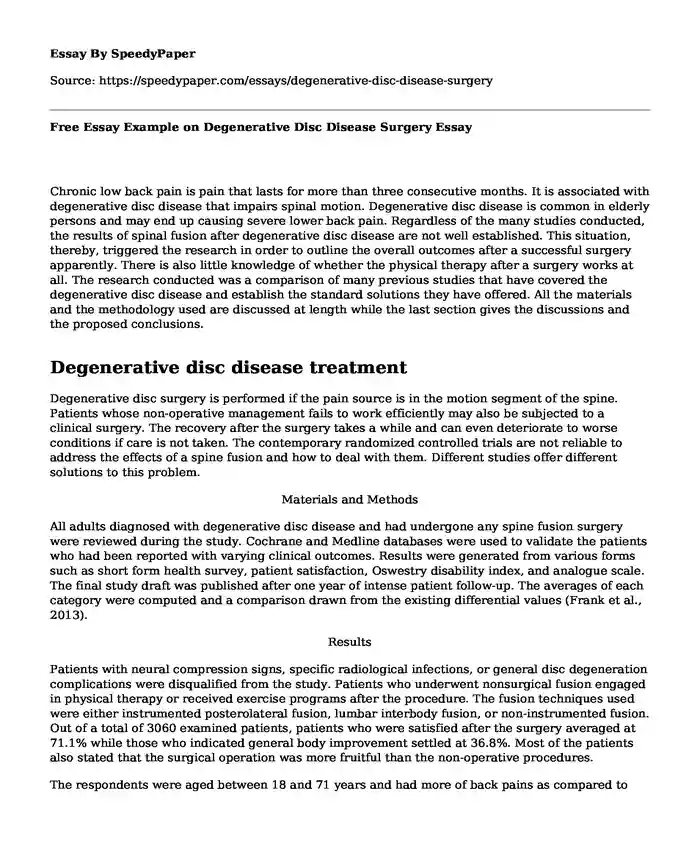
| Type of paper: | Essay |
| Categories: | Health and Social Care Medicine Surgery |
| Pages: | 3 |
| Wordcount: | 644 words |
Chronic low back pain is pain that lasts for more than three consecutive months. It is associated with degenerative disc disease that impairs spinal motion. Degenerative disc disease is common in elderly persons and may end up causing severe lower back pain. Regardless of the many studies conducted, the results of spinal fusion after degenerative disc disease are not well established. This situation, thereby, triggered the research in order to outline the overall outcomes after a successful surgery apparently. There is also little knowledge of whether the physical therapy after a surgery works at all. The research conducted was a comparison of many previous studies that have covered the degenerative disc disease and establish the standard solutions they have offered. All the materials and the methodology used are discussed at length while the last section gives the discussions and the proposed conclusions.
Degenerative disc disease treatment
Degenerative disc surgery is performed if the pain source is in the motion segment of the spine. Patients whose non-operative management fails to work efficiently may also be subjected to a clinical surgery. The recovery after the surgery takes a while and can even deteriorate to worse conditions if care is not taken. The contemporary randomized controlled trials are not reliable to address the effects of a spine fusion and how to deal with them. Different studies offer different solutions to this problem.
Materials and Methods
All adults diagnosed with degenerative disc disease and had undergone any spine fusion surgery were reviewed during the study. Cochrane and Medline databases were used to validate the patients who had been reported with varying clinical outcomes. Results were generated from various forms such as short form health survey, patient satisfaction, Oswestry disability index, and analogue scale. The final study draft was published after one year of intense patient follow-up. The averages of each category were computed and a comparison drawn from the existing differential values (Frank et al., 2013).
Results
Patients with neural compression signs, specific radiological infections, or general disc degeneration complications were disqualified from the study. Patients who underwent nonsurgical fusion engaged in physical therapy or received exercise programs after the procedure. The fusion techniques used were either instrumented posterolateral fusion, lumbar interbody fusion, or non-instrumented fusion. Out of a total of 3060 examined patients, patients who were satisfied after the surgery averaged at 71.1% while those who indicated general body improvement settled at 36.8%. Most of the patients also stated that the surgical operation was more fruitful than the non-operative procedures.
The respondents were aged between 18 and 71 years and had more of back pains as compared to the leg pains. The results in many of the studies were similar with only minor differences occurring in the demographic statistics (Frank et al., 2013).
Discussion
Despite the many studies conducted concerning degenerative disc disease, the recommendations drawn are inconclusive. Many conclusions rely on limited sources such as the fusion methods, the prospective and randomized trials conducted. Many spine fusion studies should be emphasized before making any crucial decisions (Bohl et al., 2014). The recovery after a surgery is achieved after a long time of gradual healing. There is concrete evidence from both randomized and nonrandomized studies that the pain after a spine fusion surgery decreases about the motion segment affected.
References
Bohl, D. D., Russo, G. S., Basques, B. A., Golinvaux, N. S., Fu, M. C., Long, W. D., & Grauer, J. N. (2014). Variations in data collection methods between national databases affect study results: a comparison of the nationwide inpatient sample and national surgical quality improvement program databases for lumbar spine fusion procedures. J Bone Joint Surg Am, 96(23), e193.
Phillips, F. M., Slosar, P. J., Youssef, J. A., Andersson, G., & Papatheofanis, F. (2013). Lumbar spine fusion for chronic low back pain due to degenerative disc disease: a systematic review. Spine, 38(7), E409-E422. Accessed on 14th September 2016,
Cite this page
Free Essay Example on Degenerative Disc Disease Surgery. (2017, Oct 17). Retrieved from https://speedypaper.com/essays/degenerative-disc-disease-surgery
Request Removal
If you are the original author of this essay and no longer wish to have it published on the SpeedyPaper website, please click below to request its removal:
- Free Essay Sample on Volunteer Administration Model
- Free Essay on the Ceramics of the Japanese Tea
- History of Islam Essay Sample
- Free Essay on Demystifying the Mystery of State: King Lear and the World Upside Down
- Free Essay Example on the Role of Place in Shaping Culture
- Essay Sample on Social Media and Business Enlargement
- Paper Example: Commercial Lease Vs. Residential Lease
Popular categories




